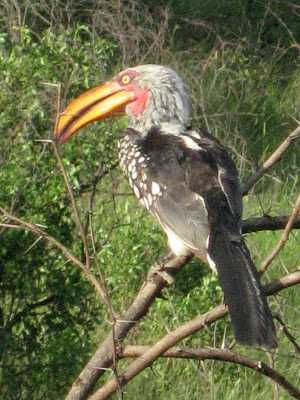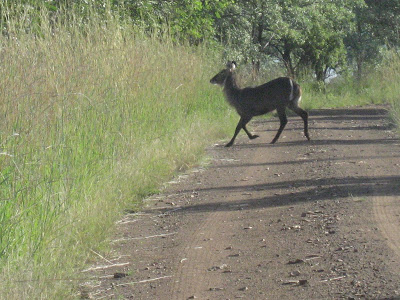Normally you don’t even see this much of a hippo. You just see the tips of the ears and snout. Also, normally, you’ll see hippos in family pods of five or more. Clearly, this loner is socially dyslexic. Within minutes, he went from watching us to warning us. Check out the jaw and spray.
Hippos can crush a crocodile in their jaws. Curiously, this explains their co-existence. The hippos don’t mind the crocs, and the crocs… well they’re fairly lazy and disgusting. If they haven’t nabbed something at the water’s edge, they’ll happily lie underwater by the hippos rump and eat, well… Gives a whole new meaning to “Day Old”.
Anyway, we were fairly far back, so we didn’t feel too threatened. This pissed off our friend who decided to impress us with the following:
For more on hippos, the meaning of ‘hippo highways’ and other bush curiosities, check out the last half of Chanda’s Wars, in which Chanda and Nelson, a young tracker, go into the bush to rescue Chanda’s young brother and sister, who’ve been kidnapped by a warlord to become child soldiers.
In the meantime, let’s see a few more of the animals I promised in the last post. Here’s a warthog.
Lions generally avoid people. But when I was in Botswana seven years ago, a lion leapt into our encampment and took down a grazing warthog. It dragged it to the edge of the compound and dispatched it. (BTW, lions tend not to kill by ripping and tearing with their teeth. Instead, they choke their victims with a heavy paw pressed down on the victim’s neck. Check out the jungle in your little kitty cat when it rests its paw over your arm.)
How about something colourful? The yellow horn bill. When it gives birth, the female moults its feathers to make a nest in a tree hole. The male seals the female and chicks inside with a mud covering, leaving only a small hole through which he slips food to feed the brood. When the babies are able to fly, Mom grows back her feathers, pecks away the mud seal, and re-emerges into the world.
As the sun went down, the animals moved toward the river to drink. Here’s a water buck, a cousin of the impala antelope. Not nearly so cute, but much more less plentiful. Luckily for the water buck, it’s not a popular game animal. It has adrenalin glands running all over the place; if it’s panicked by a hunter, the secretions make its meat taste foul.
Dusk brought us to a herd of water buffalo.
But let’s leave this safari in daylight, with one of my favourite animals: The giraffe.
Hey, take another bough.
In Chanda’s Wars, Mrs. Tafa makes the case for hunting — an understandable position from her point of view, though not my own. But what I truly find appalling is that so-called ‘hunters’ can go to private game farms and shoot these magnificent animals while they are tethered to a post. They even ‘hunt’ endangered species like rhino. (I gather a rhino kill can be bought for $20,000 in South Africa, with the horn fetching massive amounts in non-African countries practicing traditional medicine.) Let’s close with another look at what future generations may lose.
BTW, I’ll be doing a short Christmas-in-Elandsdoorn post later this week, then a post on the pandemic here, one on producer Oliver Stolz, then back to the Chanda’s Secrets set, and all all the people and things you never see on the movie screen, but without which movies would never be made. That’ll bring us into the New Year and a whole new batch of stuff.
Oh, and I haven’t forgotten about the hyena-scat-and-19th-century-missionary factoid I promised. But I’m a bit tired.Later, I promise.
Till Thursday,
Allan











You know I'm eagerly awaiting that poop story, don't you? Right on! 🙂
I don't understand the lure shooting something helpless has on some people. What could they possibly get from killing something that can't defend itself? If you're accosted by a beast and have to rumble a bit in the bush to survive, then my blessings on you. Otherwise keep your gun to yourself.
Giraffes are so neat. I love how they always look like they've got something really wise to say.
I agree on everything you say. BTW, If humans were built like giraffes, could you imagine the chiro bills? At the Buenos Aires Zoological Gardens, they sell special animal food that visitors are allowed to feed the giraffes. (Actually, you put it on a 6' wooden slide and the giraffes eat from the end of ir.) Having that long neck bend down close is something else. Still, zoos make me a little uncomfortable; I much prefer to see the animals fre in their natural environment.
Ah, the zoo. The zoo freaks me out as well. In first year Acting class we had to visit the zoo and pick an animal to study in order to "become" the animal for an hour long lab. Of course I had to pick a cross-eyed bird of some sort. Then my acting teacher told me I was too "intense". Now I associate zoos with insecurity and psychobabble.
Feeding a giraffe, I think, would be a good time. What exactly does the food consist of? Oh, the chiro bills would totally be through the roof. Lucky for me I live with a Scandinavian behemoth who can fetch things off of high shelves for me.
I love giraffes, too. I've managed to collect them everywhere I go! My motto is "Sometimes you've gotta stick your neck out."
Happy holidays!
So many neat pictures. I dislike the hunting described. I mean I get hell for putting down bucks at birth but these guys pretend to hunt helpless animals? And I'll bet the guys shooting the animal can't even kill it in one clean shot.
The rhino photo is cool. Maybe the impala should take a clue from the water buck. They're so cute!
Campbele, hi — I agree; giraffes rock!
Char, hi — not sure what the food is made of, but designed by vets especially for the animals.
Ursina, hi — and thanks for the interview.
Folks, Ursina has a terrific blog where she interviewed me. Her questions were excellent. If you want to check it out, it's at: http://farmersdaughtersbooks.blogspot.com/2009/12/wanted-allan-stratton.html
We are sell wow gold and wow power leveling and wow gold